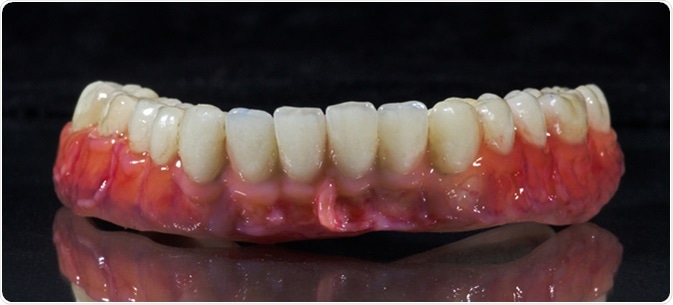Dental Bridges – Advantages and Disadvantages

Dental bridges are a suitable restorative dentistry procedure for many patients but not the only option available. To determine the appropriate use of dental bridges for each unique situation, it is prudent to consider the advantages and disadvantages of the procedure.
A dental bridge typically consists of two crowns placed on abutment teeth or implants on either side of a gap in the mouth, in addition to a pontic that joins the two crowns and fills the gap. The bridge may be constructed of various materials such as gold, silver, porcelain and porcelain-fused metals.

Advantages of Dental Bridges
There are several positive effects of dental bridges, which account for their frequency of use in restorative dental work.
Firstly, dental bridges are an effective solution for the replacement of missing teeth in the mouth, offering both functional and aesthetic correction.
In terms of function, the bridge allows a patient to chew and eat normally as there is no longer a gap in the jaw and the bridge can assist with the mastication of food. It can also help individuals to speak without inhibition, filling the gap in the teeth which may alter the placement of the tongue and the way sounds are made in the mouth.
Aesthetically, a dental bridge can compensate for the loss of the original teeth, particularly if the bridge is closely matched in color to the surrounding teeth. This can help to improve self-esteem and confidence in patients who are uncomfortable about their appearance with missing teeth.
Dental bridges can also offer benefits for the long-term structure of the mouth. Under normal circumstances, a gap in the jaw causes the teeth to gradually shift position and spread out, which can cause problems in the bite. In contrast, when the bridge is used to replace the missing teeth, the teeth on either side are held firmly in place to reduce the risk of movement and consequent problems of the bite. Additionally, the bridge can also help to reduce the risk of bone loss from the jaw and, therefore, maintains the facial structure.
Many patients also prefer dental bridges because of the way they feel in the mouth and their easy maintenance. A short time is usually needed for a patient to become accustomed to the feel of the dental bridge, after which it is hardly noticeable because it becomes a part of the mouth structure. Unlike dentures, bridges do not need to be removed regularly for cleaning and can be cleaned just like natural teeth by brushing.
Disadvantages of Dental Bridges
However, there are also several drawbacks linked to the use of dental bridges in restorative dentistry.
Firstly, the healthy abutment teeth on either side of the gap that hold the pontic in place may become damaged in some cases, after the bridge is fitted. For example, there is a risk of decay of if the bridge and crowns are not well fitted and allow plaque and bacteria to enter underneath them. Additionally, the structure of the teeth may change following the placement of the crowns and bridge.
For some patients, the supporting abutment teeth have insufficient strength to hold the bridge and consequently collapse. This presents additional problems that will need to be addressed and may even worsen the original situation. In severe cases, the abutment teeth may eventually need to be replaced by dental implants.
Weighing up the Advantages and Disadvantages
The best type of restorative dental treatment will depend on the specific case, and the advantages and disadvantages should be considered in the decision-making process. It is mandatory for the dentist to present the different options to patients, alongside the risks and benefits of each possibility, so that together they can make the optimal decision.
References
- https://dentalcareofpomona.com/advantages-risks-choosing-dental-bridge-replace-missing-tooth/
- http://www.infodentis.com/dental-bridge/dental-bridges-advantages.php
- https://www.dentaldepartures.com/article/advantages-and-disadvantages-of-dental-bridges/ (opened to a blank page)
- https://www.dentalimplantsusa.com/treatment/bridge-for-single-tooth-replacement/
- http://www.intelligentdental.com/2011/08/24/advantages-and-disadvantages-of-dental-bridges-2/
Further Reading
- All Dental Bridge Content
- What is a Dental Bridge?
- Types of Dental Bridges
- Dental Bridge Procedure
- Uses for a Dental Bridge
Last Updated: Feb 26, 2019

Written by
Yolanda Smith
Yolanda graduated with a Bachelor of Pharmacy at the University of South Australia and has experience working in both Australia and Italy. She is passionate about how medicine, diet and lifestyle affect our health and enjoys helping people understand this. In her spare time she loves to explore the world and learn about new cultures and languages.
Source: Read Full Article